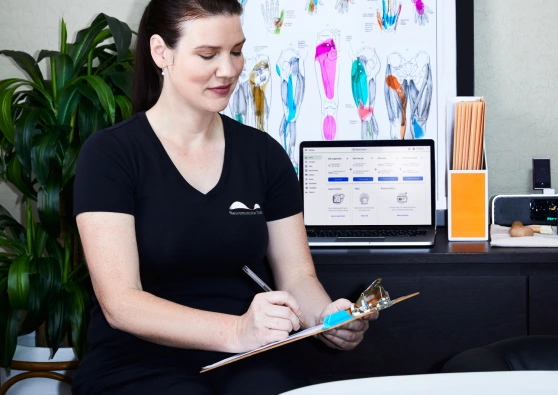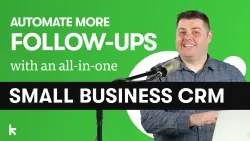For an entrepreneur in independent consulting, following up with leads and closing deals is your business’s lifeblood. Getting that “Yes” from a new client gets a noticeable rush.
Now, in most cases, delivering the goods is not a problem for a consultant. They know their own expertise, which is why they have a business in the first place. There is a reason people pay them to get the job done.
Here is the problem: time spent doing the fulfillment of the project is not time spent selling new deals.
It is easy to get off balance and get buried in project work and ignore the key sales activities that you know drive the business.
For any independent consultant who wants to take their business to the next level, they can absolutely benefit from using a formal pipeline to drive the sales process.
How Does a Consultant’s Sales Pipeline Work?
Think of the independent consultant sales process as a set of stairs, where each step gets closer to the ultimate goal of the top (a sale).
A common problem for consultants and coaches when setting up a pipeline in their CRM is organizing distinct stages. Getting clear on each step in a consultant’s sales pipeline is key to enable a smooth sales process. If you build a pipeline with poorly thought out stages, the tool actually becomes an obstacle in the sales process. Automating parts of your sales and marketing engine become even more difficult as a result.
Let’s discuss a tested and proven set of sales stages for independent consultants. We’ll also share some ideas for automation that enhance the client experience.
Top-of-Funnel Pipeline Sales Stages for Independent Consultants
Most independent consultant pipelines skip over leads who aren’t immediately ready to buy. This means potential sales with longer close times slip through the cracks. Fortunately, these early stages are easy to incorporate and give great visibility into your full independent consultant sales pipeline.
1. New Lead
A new lead is fresh and has not yet been contacted. The only thing that has happened is someone has been identified for the sales process. You still don’t know if this person is interested in your consulting services. The point is you need to reach out and push ahead the conversation.
2. Contacting
This is when you begin outreach to try and make contact with a new lead. Differentiating brand new leads from ones that have started to enter the pipeline makes sure your sales team can ensure fast replies to get leads into this contacting stage as soon as possible.
3. Engaging
At this next stage, a lead has made contact back with us and is engaging. As an independent consultant it is helpful to know who is actively engaging so you can better gauge interest in your services.
4. Qualified
Leads who are qualified want to work with you, and you want to work with them. In other words a qualified lead is ready to move into the next major phase of the sales cycle: an initial meeting.
Like a staircase, some leads in your consulting sales pipeline can skip some steps. You may go from a New Lead to Qualified or beyond in the first point of contact. But if not, the other stages are there to make sure nobody ever slips through the cracks.
Middle-of-Funnel Pipeline Sales Stages for Independent Consultants
Many independent consultants might be tempted to start in the middle of the consulting pipeline. This part is where the initial proposals are sent out, needs are evaluated, and you’re certain this person is interested in your service.
These stages are designed to get your leads into the final sales stages. Using a pipeline here is especially critical to make sure all potential clients are being given the attention they deserve.
5. Appointment Scheduled
Qualified leads in this stage schedule the first formal sales call. They are active in the sales process and in a holding pattern until the appointment happens.
6. Appointment Complete
After the appointment is complete, the lead may or may not have provided all the information needed for a proposal. There is more work to be done.
(In the case where your sales process almost always has two formal sales calls, you may want to make a set of two appointment scheduled/complete stages.)
7. Proposal Needed
Leads in this stage need a formal proposal to move ahead with the consulting project. This stage is critical because you need to get proposals out in a timely manner. The ball is in your court.
Bottom-of-Funnel Pipeline Sales Stages for Independent Consultants
This is the final set of actions before sealing the deal and the top of the “staircase”.
These final stages ensure the deal gets closed and everything is set for you to get started on a new consulting project.
8. Proposal Sent
This is a distinct sales pipeline stage to track everyone who has received a proposal. Now that the ball is back in the potential client's court, following up is key to closing the sale.
9. Proposal Negotiation
Sometimes, there is work to be done to finalize a proposal that the client will accept. This stage is to keep track of hot leads that are actively discussing the proposal and revisions.
10. Proposal Accepted
Huzzah! These leads have accepted the proposal and are basically a paying client. This stage is there to make sure these ultra hot leads actually become a paying client.
11. Deposit Collected (Won)
This is it. We made it to the top of the sales stairs! The deposit has hit the bank and everyone is now a happy client. In most cases this is the end of the journey for the lead. The sales journey anyway. They are now a paying client and their fulfillment journey begins.
Bonus: Two Special Pipeline Sales Stages for Independent Consultants
There are two more stages that consulting professionals may want to consider that are unique to the line of work.
12. Long-Term Nurture
This is a holding stage for leads that aren't quite ready for your service. Although they don’t need as much follow up, they should still be checked up on. This is the stage you put someone in who is taking a vacation for a few months or when they will be ready to start a project next year because of reasons unrelated to you. These leads are an easy close if you simply don't forget about them.
13. Lost
This is a hard pill to swallow for some independent consultants. Not every lead becomes a sale. And those leads need to be put into this lost stage so we do not continue to spend resources on them. This is distinct from the long-term nurture stage because we do NOT follow up with people in the lost stage.
To sum it up, most independent consultants will be able to use the following stages in their sales pipeline:
- New Lead
- Contacting
- Engaging
- Qualified
- Appointment Scheduled
- Appointment Complete
- Proposal Needed
- Proposal Sent
- Proposal Negotiation
- Proposal Accepted
- Deposit Collected (Won)
- Long-Term Nurture
- Lost
Automating a Sales Pipeline for Consultants
Automation can revolutionize your mostly manual sales process, but only when the process itself is clear. With clarity into the independent consultant pipeline stages, we can explore some ways to go world-class with automation.
Keep in mind that automation should enhance the relationship and support what the consultant should already be doing. Good automation is all about relationships-at-scale. Even if the same email goes out a thousand times, it still feels one-to-one every time (“someone who cares about me wrote this” - recipient). The win for consultants is the ability to do more with the same team and close more deals.
Keap’s CRM with sales and marketing automation software lets you automate and personalize your stages, correspondence, and so much more.
Top-of-Funnel Automation
For the top of the funnel sales stages, automation can be a great way to stay top of mind without commanding much of your time that can be better spent working on fulfilling projects or closing deals.
For example, rather than manually replying to contact forms, save yourself the time and have a fast response time, automatically. Automation can also be very helpful to pull slower leads through early on. Since those leads haven't responded yet, you can send a short series of emails and texts to try and engage them. When people are in the engaging stage, this is a good time to drive them to your most informative content.
Middle-of-Funnel Automation
For the middle of the funnel, automation can help with organization. For example, when someone schedules an appointment, you can automatically send out reminders leading up to the date. This can include more resources and things they can do to prepare for the call. You can even give an option to reschedule a call so you don’t miss a beat.
Bottom-of-Funnel Automation
As a lead approaches the final steps in the funnel, you can have a short-term nurture in the proposal sent stage. Create an email campaign that shares competitor comparisons and compelling data on why your proposal is competitive.
Final Thoughts
These are all straightforward automation ideas most independent consultants can use to enhance their sales processes. The difference between a successful and a struggling independent consultant is always their well thought out sales process. By using a sales pipeline in your business, you create a digital net to help ensure no leads ever slip through the cracks!
Want to explore if Keap is the best independent consultant pipeline for you? Start a 14-day free trial to build your pipeline.
About the Author

Paul started using Keap, then Infusionsoft, in the summer of 2008. By June 2009 he was part of the Certified Marketing Automation Coach (CMAC) program, Keap’s partner program at the time. That lasted until 2011 when he worked for Keap directly in coaching and product until May 2016, at which point he became a certified Keap partner again to serve entrepreneurial small businesses.



